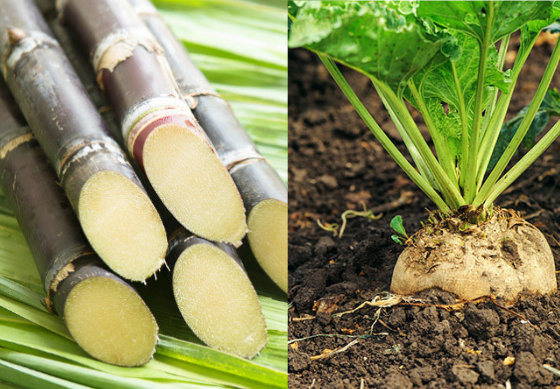The discussion of beet sugar vs cane sugar often includes comparisons of their effect on blood sugar.
The discussion of beet sugar vs cane sugar often includes comparisons of their effect on blood sugar.
Blog Article
Discover the Uses and Conveniences of Beet Sugar Vs Cane Sugar in Your Daily Diet Regimen
Discovering the unique qualities of beet and cane sugar exposes greater than simply their sweetening capabilities; it highlights their special impacts on health and wellness and culinary arts. Beet sugar, recognized for its subtle flavor, is often preferred in fragile desserts, whereas cane sugar, with its hint of molasses, includes richness to durable meals. Each kind holds its own dietary profile and glycemic effects, inviting a much deeper understanding of their duties in a well balanced diet plan and lasting usage techniques.
Origin and Manufacturing Procedures of Beet and Cane Sugar

The distinct environments and soil types needed for expanding sugar beets and sugarcane contribute to distinctions in their farming techniques and geographic circulation, influencing the economics and sustainability of their manufacturing. beet sugar vs cane sugar.
Nutritional Contrast In Between Beet Sugar and Cane Sugar
Despite originating from different plants, beet sugar and cane sugar are nutritionally extremely comparable, both largely including sucrose. Each provides regarding 4 calories per gram, converting to about 16 calories per teaspoon. Structurally, both sugars are composed of roughly 99.95% sucrose, with minimal amounts of other compounds like wetness and trace minerals, which do not dramatically modify their dietary accounts.

Inevitably, when picking in between beet sugar and cane sugar based on nutritional content alone, both offer similar benefits and downsides as they are basically forms of the same molecule-- sucrose, giving quick energy without various other nutrients.
Influence On Health And Wellness: Glycemic Index and Caloric Content
Checking out even more into the results of beet sugar and cane sugar on wellness, it is vital to consider their glycemic index and calorie material. Both sugars are categorized as sucrose, which contains sugar and fructose. This structure leads them to have a similar influence on blood sugar level levels. The glycemic index (GI) of both beet and cane sugar is around 65, categorizing them as high-GI foods, which can trigger quick spikes in blood sugar levels. This is a click here for more info vital aspect for people handling diabetes or those attempting to support their power levels throughout the day.
Each kind of sugar includes around 4 calories per gram, making their caloric web content equivalent. For those monitoring caloric intake, especially when managing weight or metabolic health and wellness conditions, comprehending this equivalence is vital (beet sugar vs cane sugar). Too much consumption of any type of high-calorie, high-GI food can add to health concerns such as weight problems, heart disease, and insulin resistance.
Environmental and Economic Considerations of Sugar Manufacturing
Beyond health effects, the manufacturing of beet and cane sugar additionally raises considerable ecological and economic problems. Sugar beet cultivation has a tendency to need cooler environments and has a lower geographical footprint compared to why not find out more sugar cane, which grows in tropical areas. Nevertheless, both plants are intensive in terms of water usage and land profession, possibly leading to deforestation and water shortage. Financially, the global sugar market is highly volatile, influenced by modifications in international profession plans and aids. Many countries incentivize sugar manufacturing via financial backing, skewing market value and impacting small-scale farmers negatively.
Additionally, the use of chemicals and plant foods in both beet and cane sugar farming can cause dirt deterioration and contamination, additional affecting biodiversity and local water bodies (beet sugar vs cane sugar). The choice between cultivating sugar beet or cane frequently depends upon local environmental problems and economic elements, making the sustainability of sugar production a complex concern
Culinary Applications and Taste Differences
While the environmental and financial facets of sugar production are certainly significant, the selection in between beet and cane sugar likewise influences cooking applications and taste profiles. Beet more sugar, originated from the sugar beet plant, is recognized for its incredibly neutral taste. This makes it a functional component in cooking, where it does not modify the flavor of other parts. It liquifies rapidly and is perfect for usage in cakes, cookies, and pastries.
Walking cane sugar, extracted from sugarcane, usually maintains molasses traces, which impart a distinct richness and deepness. This small molasses taste enhances the intricacy of baked goods, sauces, and marinates. It is specifically favored in things where a caramel undertone is desired, such as in brownies or gingerbread. In addition, the small variant in dampness material in between beet and cane sugar can influence the structure and uniformity of dishes, making cane sugar a favored selection for details recipes that gain from its one-of-a-kind residential or commercial properties.

Verdict
In verdict, both beet and cane sugar have distinct origins and manufacturing procedures, using comparable nutritional profiles with slight differences in sodium content and taste. While their influence on wellness, especially pertaining to glycemic index and calories, is equivalent, the option between them typically boils down to ecological, financial factors, and specific cooking requirements. Comprehending these elements can direct customers in making educated decisions that align with their wellness objectives and flavor preferences.
Report this page